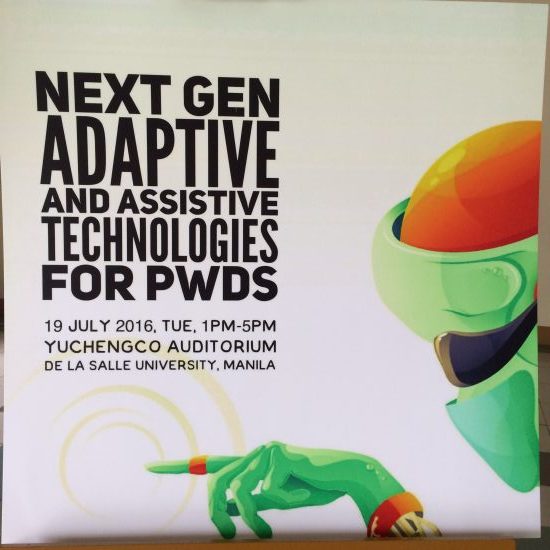Robots teaching autistic children? I was in a seminar sponsored by the Autism Society Philippines on July 19 at the De la Salle University’s Yuchengco Auditorium. The development of next-gen adaptive and assistive technologies for PWDs was the focus of this seminar and two of De Lasalle’s science professors Clement Ong and John Cabibihan were on hand to talk about the research and studies they have done aimed at helping autistic children learn. Both professors have been active in developing practical applications of robots, particularly Cabibihan who has made studies in the use of social robotics for teaching autistic children.
 |
| De la Salle professor Clement Ong shares his discoveries. |
In my opinion, there is a great deal to be accomplished to make the use of robots part of mainstream methodologies in the education of autistic children. As the representative of Philhealth mentioned, technology need not be a gadget or anything high tech. It could be as complicated as management software on a smartphone or as basic as a walking stick. Robots teaching autistic children has yet to be seen to be effective, even in the first-world countries. What is needed are technologies that can be used here and now. What is important is that assistive technology, in whatever form or function, become affordable, available and government-approved.
Persons with Disabilities need emerging technologies that will help integrate them into mainstream society. There exists a very clear cut divide between the disabled and non-disabled and because the disabled are a minority, it is easy to dismiss them. Besides, what is 1.6% of the total population? Very marginal.
However, in the Philippine setting, family ties are usually very strong and in most households that have a PWD in the family, there will be at least two or three persons taking care of the PWD, making the 1.6% ballooning to three or even four times that number. The caretakers of PWDs are just as important stakeholders as the PWDs themselves.
The good news is that PhilHealth has approved the funding for PWDs who need wheelchairs, walking sticks, hearing aids and other similar assistive instruments. If you need to know more about what how to apply to PhilHealth, please go to this website. As of now, hearing aids are covered by PhilHealth, but not cochlear implants. These implants are more efficient and better than hearing aids, but because there is no large demand, the price of one implant is still prohibitive.
 |
| Image borrowed from www.technocrazed.com |
Challenges to the development of assistive technologies
One of the biggest hurdles to the development of such technologies is the lack of data. PhilHealth, upon approval of the budget amendments for persons with disabilities, needed to conduct their own survey to determine which disability was the most common among the PWDs in the Philippines. It turned out that the highest number of PWDs were the visually challenged. No exact statistics were given. This is the same problem with other groups developing adaptive and assistive technologies; the gap of not know who they should be developing for. One cannot make a dent of a difference if there is no specific niche for which the technology will be used.
How are they fixing this lack of research data
In PWDPhil.com, many have called and asked for assistance regarding the availability of relevant statistics for the PWD community. Sadly, the NCDA admitted that their data was as old as 2010 and were not as updated. There was a request for the Philippine Statistics Office to include certain questions directed at finding out at least how many PWDs were in each household, since a nationwide demographic study is made anyway on a yearly basis. This extra question would be both important and a cost-saver. At the same time, the resulting statistics can be used to extrapolate other relevant data crucial to the development of next-generation adaptive and assistive technologies. Time-to-market of these devices can be greatly lessened and be made available earlier than anticipated.
Many PWDs and their caretakers are praying that such high tech can be made available and affordable to those who need it. More often than not, assistive technologies used by the PWDs end up being used by senior citizens, who hearing, eyesight and health begin to fail in their twilight years. Walkers, canes, wheelchairs and hearing aids eventually become mainstream as the population ages and demand for these devices go up.
This is the very reason that we need to elevate the level of discussions on PWD rights and tech. If we do not continue and sustain the discussions, offline or online, our community will be marginalized and will only be important when politicians need to have bleeding hearts on their side to win elections. The PWD community is not a group to be abused and exploited, it is a community of real, functional and exceptional people who have the right to be seen, heard and consulted.
 |
| From ASP event DLSU |

